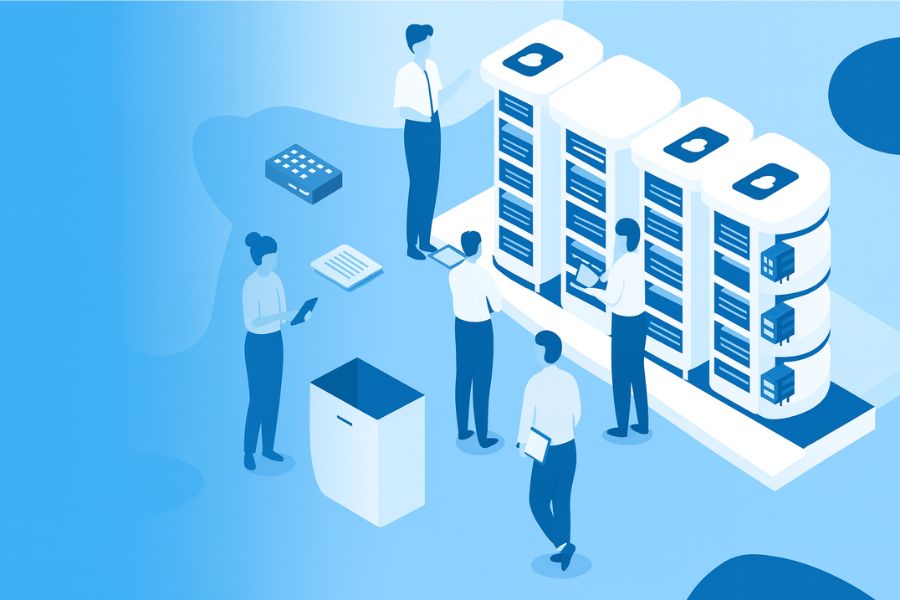
The digital economy in Europe has entered a phase where uptime, security, and performance are not optional; they are mission-critical. With industries such as fintech, healthcare, eCommerce, and SaaS depending on seamless service delivery, even a few minutes of downtime can cost thousands of euros and irreparably damage customer trust.
European enterprises face mounting pressures from GDPR, NIS2, and SLA-driven expectations. A website or platform that goes offline is no longer viewed as an inconvenience, it’s seen as a critical service failure. This is where DCIM Data Center Infrastructure Management) is transforming the hosting ecosystem.
Businesses frequently ask: “What is a DDoS-protected dedicated server?” The answer goes beyond security. A DDoS-protected dedicated server in a DCIM enabled facility doesn’t just block malicious traffic; it operates within an environment where every infrastructure variable from power to cooling to bandwidth is continuously monitored to ensure reliability.
Hosting providers that integrate DCIM tools such as Schneider EcoStruxure, Nlyte, or Sunbird gain visibility into every detail of their data center operations. This allows them to predict failures, automate responses, and guarantee near-perfect uptime.
What Is DCIM and Why It Matters
DCIM (Data Center Infrastructure Management) refers to the integration of IT and facility management disciplines to centralize monitoring and management of critical systems. Unlike traditional monitoring tools that track isolated metrics, DCIM provides a single pane of glass view of:
- Power usage and redundancy
- Cooling efficiency and airflow management
- Rack space utilization
- Network bandwidth and latency
- Environmental conditions (temperature, humidity, vibration)
- Physical security and access logs
By consolidating these metrics, DCIM allows providers to make data-driven decisions that minimize downtime and maximize performance.
Executives often ask: “Which type of server is best?” The best-performing server is not just about CPU or RAM it’s the one colocated in a DCIM-enabled facility, where predictive monitoring ensures uptime and reliability.
How DCIM Improves Hosting Reliability
Reliability in hosting is measured by uptime, response speed, and stability under load. DCIM directly improves reliability through:
- Real-time monitoring: Detects anomalies in power draw, cooling performance, and server utilization.
- Predictive analytics: Uses AI to forecast failures before they occur.
- Faster root-cause analysis: Minimizes mean time to repair (MTTR).
- Energy optimization: Ensures stable cooling and prevents overheating-related outages.
One common question enterprises raise is: “What is the most reliable server?” The most reliable server is housed in a DCIM-managed facility, where constant monitoring reduces the risk of downtime.
DCIM and SLA Uptime Guarantees
Across Europe, hosting providers proudly advertise 99.9% or even 100% SLA uptime guarantees. These commitments are designed to reassure businesses that their websites, applications, and mission-critical platforms will remain accessible at all times. However, without robust Data Center Infrastructure Management (DCIM) in place, such guarantees are difficult to uphold in practice.
DCIM bridges this gap by giving providers end-to-end visibility into every infrastructure component that contributes to uptime from power distribution units and cooling systems to server racks and network switches. By monitoring these elements continuously, DCIM ensures that potential failures are detected early.
It also enables automated incident logging and SLA reporting, allowing providers to demonstrate compliance with contractual obligations. If anomalies occur, DCIM-driven analytics help operators proactively redistribute loads across racks, optimize cooling, or re-route network traffic before disruptions escalate.
A frequent business question is: “How much does a dedicated server cost?” While pricing typically ranges from €150–€400 per month, the real differentiator is not just the hardware but the SLA uptime guarantee backed by DCIM monitoring. Providers using DCIM can genuinely honor their promises, making uptime a measurable and enforceable standard rather than a marketing claim.
Impact on Data Center Operations
DCIM changes how data center operations are managed by bridging the gap between IT teams and facilities teams. It centralizes asset tracking, cabling maps, and maintenance schedules, while also automating many routine tasks.
- Automated alerts: Teams receive instant notifications for power anomalies.
- Workflow management: Assigns and tracks tickets for operational issues.
- Capacity planning: Ensures providers know when to expand racks or cooling.
Enterprises often ask: “Is dedicated IP faster?” Yes. And when combined with DCIM-managed routing, dedicated IPs ensure consistency, fast issue resolution, and reliable performance.
DCIM and Scalability
As businesses grow, scalability becomes a top priority. DCIM enables predictive scaling by showing when resources are nearing limits.
- Capacity modeling: Predicts when more racks, cooling, or bandwidth are required.
- Load balancing: Optimizes usage across multiple racks or data halls.
- Hybrid integration: Manages colocation and private cloud simultaneously.
A common query is: “Is a dedicated server better than VPS?” The answer: Yes, particularly when backed by DCIM. Dedicated servers gain the advantage of scalability and proactive resource management.
Compliance and Risk Management
European enterprises must align with GDPR, NIS2, PCI-DSS, and ISO 27001. DCIM helps achieve compliance by:
- Logging access attempts and changes to infrastructure.
- Generating reports for audits automatically.
- Tracking energy consumption for environmental compliance.
Businesses often ask: “Do you need a good GPU to run a dedicated server?” The answer is no. Reliability and compliance depend on infrastructure monitoring through DCIM, not GPU acceleration.
DCIM vs Legacy Monitoring
Traditional monitoring tools were designed for a simpler time in data center operations. They typically tracked isolated metrics such as temperature, power usage, or network connectivity. While useful, these legacy systems provide only a fragmented picture of infrastructure health. Teams relying on them often face manual intervention, delayed responses, and reactive troubleshooting. For example, a cooling system alert may be triggered, but without visibility into rack density or airflow, the root cause could take hours to identify.
By contrast, DCIM (Data Center Infrastructure Management) integrates multiple layers into one system. It delivers predictive, automated, and cross-functional insights that allow operators to anticipate issues before they escalate. DCIM correlates data from power distribution, cooling, server utilization, and environmental sensors to create a holistic view. This enables faster decision-making, reduces mean time to repair (MTTR), and supports compliance reporting.
Businesses often ask: “How much does Bluehost cost?” While shared hosting may cost a fraction of enterprise services, its environments lack DCIM-backed transparency and reliability. Enterprise-grade providers invest in DCIM because it enables scalable, resilient infrastructure ensuring uptime guarantees that budget hosts simply cannot match.
In short, legacy monitoring reacts, but DCIM prevents.
Role of DCIM in Colocation and Managed Private Cloud
DCIM (Data Center Infrastructure Management) delivers significant advantages for enterprises relying on server colocation or managed private cloud environments.
In colocation, DCIM ensures hosting providers maintain strict SLA uptime commitments by constantly monitoring power, cooling, and bandwidth usage. It also simplifies compliance by generating detailed logs for audits and tracking infrastructure performance in real time.
For managed private cloud, DCIM adds visibility into how resources are allocated and billed. Businesses benefit from transparency, ensuring they only pay for what they use while gaining performance insights across virtualized workloads.
In hybrid environments, where enterprises combine colocation with private or public cloud, DCIM acts as a unifying layer. It creates a single dashboard for monitoring on-premises hardware alongside cloud-based assets, eliminating silos between teams.
Businesses often ask: “What is the best dedicated IP provider?” The most reliable providers are those combining RIPE-assigned IPs with DCIM monitoring, guaranteeing uptime and reputational safety.
Case Studies: Industries Benefiting from DCIM
Finance & Banking
Transaction-heavy environments demand zero downtime. DCIM provides audit trails and predictive scaling that ensure stability.
Gaming & Esports
DCIM ensures low latency during tournaments and prevents downtime during traffic spikes.
Healthcare
Hospitals require uptime for patient portals and electronic medical records. DCIM ensures data availability and compliance.
eCommerce
Abandoned carts and lost sales during downtime are mitigated by DCIM’s proactive monitoring.
Government & Public Sector
Critical services rely on DCIM for redundancy and infrastructure transparency.
Query tie-in: “Which is the best server in the world?” The answer: an enterprise-grade server colocated in a DCIM-enabled European facility.
Future of DCIM in European Data Centers
AI & Machine Learning
Predictive analytics will allow failures to be addressed before they occur.
5G Integration
With more IoT devices, DCIM will monitor edge micro data centers.
Hybrid Models
DCIM will combine on-premises insights with cloud-based dashboards.
Zero Trust Security
Every request will be validated, aligning DCIM with modern security models.
Question tie-in: “What is the best CPU for a dedicated server?” AMD EPYC and Intel Xeon continue to lead, but DCIM ensures those CPUs deliver maximum reliability.
Why Enterprises Need DCIM for Hosting Reliability
In 2025, hosting reliability is no longer determined by hardware power alone it depends on the intelligence of the infrastructure behind it. This is where DCIM (Data Center Infrastructure Management) becomes indispensable. By combining predictive monitoring, automated workflows, and compliance-ready reporting, DCIM empowers businesses in Europe to move beyond reactive fixes and embrace proactive reliability.
Enterprises often ask: “Does Contabo VPS have a GPU?” The answer is yes in some cases, but the real question should be: “Does the provider operate within a DCIM-enabled data center?” Without DCIM, even powerful servers with GPUs or high-performance CPUs risk downtime due to overlooked cooling inefficiencies, power distribution problems, or missed alerts.
With NexonHost’s DCIM-backed infrastructure, enterprises gain far more than servers. They gain resilient uptime, compliance assurance, and the ability to scale confidently across colocation, private cloud, or dedicated server environments. From eCommerce sites processing thousands of orders daily to financial institutions handling sensitive transactions, every industry benefits from DCIM’s ability to minimize risk and maximize efficiency.
The future of hosting reliability in Europe is inseparable from DCIM. Businesses that prioritize it today will be the ones leading in security, compliance, and performance tomorrow.

